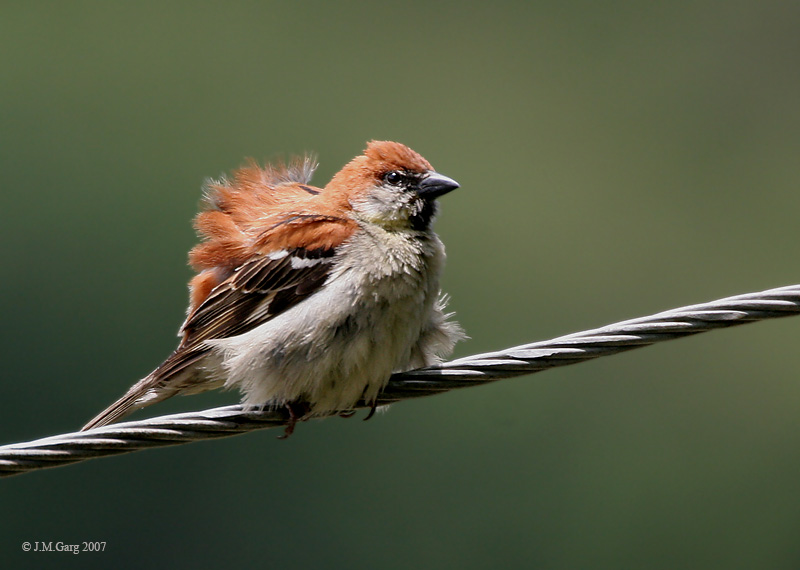|
| 질의: ground parrot | 결과: 61번째/62 | |
Old World Sparrow (Family: Passeridae, Genus: Passer) - Wiki
| 제목: | Old World Sparrow (Family: Passeridae, Genus: Passer) - Wiki
| |

| 해상도: 800x570
파일크기: 122760 Bytes
촬영일: 2007:05:12 11:58:08
사진기: Canon EOS 350D DIGITAL (Canon)
F number: f/6.3
Exposure: 1/500 sec
Focal Length: 500/1
등록시간: 2007:11:13 21:32:08
|
ERROR : Server Busy(-1105)
ERROR : Server Busy(-1105)
Old World Sparrow (Family: Passeridae, Genus: Passer) - Wiki
Passer
From Wikipedia, the free encyclopedia
[Photo] Russet Sparrow (Passer rutilans) in Kullu - Manali District of Himachal Pradesh, India. Date 12 May 2007. Author J.M.Garg (http://commons.wikimedia.org/wiki/User:J.M.Garg) Copyright (C) 2007 J. M. Garg
Permission is granted to copy, distribute and/or modify this document under the terms of the GNU Free Documentation License, Version 1.2 or any later version published by the Free Software Foundation; with no Invariant Sections, no Front-Cover Texts, and no Back-Cover Texts. A copy of the license is included in the section entitled "GNU Free Documentation License". |
Scientific classification
Kingdom: Animalia
Phylum: Chordata
Class: Aves
Order: Passeriformes
Family: Passeridae
Passer is a genus of Old World sparrows. Most of its members are found naturally in open habitats in the warmer climates of Africa and southern Eurasia. Several species have adapted to human habitation, and this has enabled the House Sparrow in particular, invariably in close association with man, to extend its Eurasian range well beyond what was probably its original home in the Middle East, .
Apart from this semi-natural colonisation, the House Sparrow has been introduced to many parts of the world outside its natural range, including the Americas, sub-Saharan Africa and Australia. The Tree Sparrow has also been artificially introduced on a smaller scale, and there are populations in Australia and locally in Missouri and Illinois in the United States.
Passer sparrows build an untidy nest, which, depending on species and nest site availability, may be in a bush or tree, a natural hole in a tree, in a building or in thatch, or in the fabric of the nest of species such as the White Stork. The clutch of up to eight eggs is incubated by both parents typically for 12-14 days, with another 14-24 more days to fledging.
These sparrows are small passerine birds, typically 10-20 cm long. They are plump brown or greyish birds often with black, yellow or white markings, and with short tails and stubby conical beaks. They are gregarious and will form substantial flocks, and some, though not the House Sparrow, have pleasant songs.
Passer sparrows are primarily ground-feeding seed-eaters, though they also consume small insects especially when breeding. A few species like the House Sparrow and Grey-headed Sparrow scavenge for food around cities, and are almost omnivorous.
Species list
Saxaul Sparrow, Passer ammodendri
House Sparrow, Passer domesticus
Spanish Sparrow, Passer hispaniolensis
Sind Sparrow, Passer pyrrhonotus
Somali Sparrow, Passer castanopterus
Cinnamon Sparrow or Russet Sparrow, Passer rutilans
Pegu Sparrow or Plain-backed Sparrow, Passer flaveolus
Dead Sea Sparrow, Passer moabiticus
Rufous Sparrow, Passer motitensis
Socotra Sparrow, Passer insularis
Iago Sparrow or Cape Verde Sparrow, Passer iagoensis
Cape Sparrow or Mossie, Passer melanurus
Grey-headed Sparrow, Passer griseus
Swainson's Sparrow, Passer swainsonii
Parrot-billed Sparrow, Passer gongonensis
Swaheli Sparrow, Passer suahelicus
Southern Grey-headed Sparrow, Passer diffusus
Desert Sparrow, Passer simplex
Eurasian Tree Sparrow, Passer montanus
Sudan Golden Sparrow, Passer luteus
Arabian Golden Sparrow, Passer euchlorus
Chestnut Sparrow, Passer eminibey
Italian Sparrow, Passer italiae
Kenya Rufous Sparrow, Passer rufocinctus
Kordofan Rufous Sparrow, Passer cordofanicus
Shelley's Rufous Sparrow, Passer shelleyi
Asian Desert Sparrow, Passer zarudnyi
http://en.wikipedia.org/wiki/Passer
| The text in this page is based on the copyrighted Wikipedia article shown in above URL. It is used under the GNU Free Documentation License. You may redistribute it, verbatim or modified, providing that you comply with the terms of the GFDL. |
|
^o^
동물그림창고 똑똑전화 누리집
^o^
|
|

